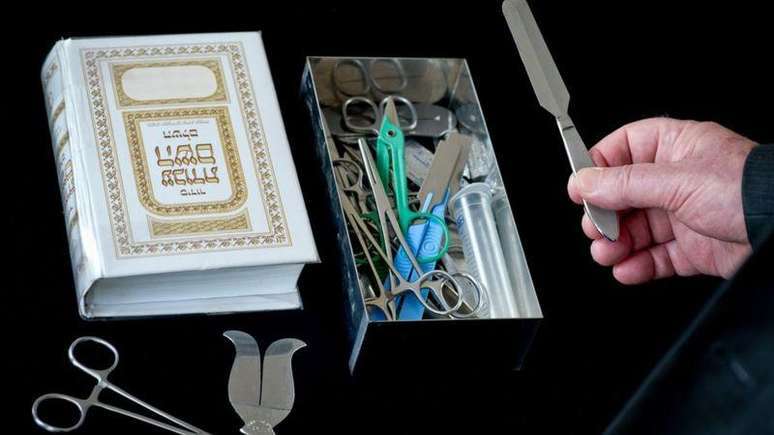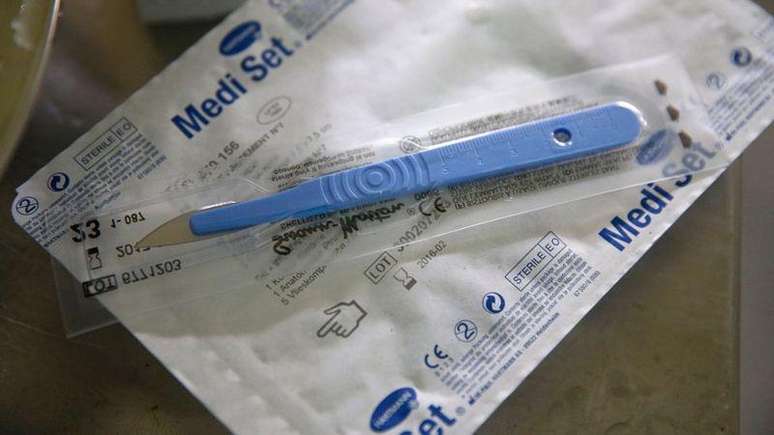Foreskin removal is surrounded by myths, half-truths and speculation – know what the science says.

Circumcision has been practiced for thousands of years.
Historians believe that it existed as early as 15,000 years ago in Egyptian society and has come down to the present day, with about one in three circumcised men in the world.
Circumcised men – that is, those who have had the foreskin cut off their penis, leaving the glans exposed – are mostly Muslims. In Islam, circumcision is performed as a ritual on infants, just as it is in Judaism.
In second place are men born in the United States – 80.5%, according to 2016 data. In that country, circumcision has been considered a beneficial medical intervention for decades.
Most circumcisions are performed immediately after birth. Uncircumcised men may need to have the surgery later for health reasons.
Here are the scientific answers to four questions about circumcision.
1. What is the biological function of the foreskin and what happens when it is severed?
The foreskin is the part of the skin on the penis that covers the glans penis.
Unlike the rest of the skin on the penis, which is attached to the organ, the foreskin is loose. Under normal conditions, the foreskin should be able to recede until the glans is completely uncovered, both in the flaccid state and during erection.
The inner surface of the foreskin is a lubricated mucous membrane, similar to the inside of the mouth or vagina among women.
“Its function is to cover the organ and act as a lining,” according to urologist Ana María Autrán, of the American Confederation of Urology.
Experts also believe that the foreskin may have an immune function.
Men can do without the foreskin, but the glans is a very sensitive area of the penis. When the foreskin is removed for health reasons in childhood, adolescence or adulthood, the previously protected glans is now in direct contact with air and clothing.
Therefore, in the first weeks, the patient feels discomfort caused by the contact of the glans penis with the tissues. And you may also experience pain during erections. But, over time, the skin on the glans becomes stiffer and loses some of its sensitivity.

Surgery is usually done in two ways: the traditional way, by cutting the foreskin with a scalpel, or with a surgical stapler. Only local anesthesia can be applied, although, many times, the patient is sedated before surgery in such a sensitive region of the body.
2. When is it necessary to undergo circumcision?
Leaving religious reasons aside and focusing on health reasons, there are different opinions on the matter.
On the one hand, there is the majority position in the United States that it is preferable to circumcise children at birth. According to the American Academy of Pediatrics (AAP), “the health benefits of male circumcision in the newborn outweigh the risks.”
Among these benefits, the organization cites the prevention of urinary tract infections, penile cancer and the spread of some sexually transmitted diseases, including HIV/AIDS.

“Male circumcision performed during the newborn period has significantly lower complication rates than when performed later in life,” according to the AAP.
On the other hand, the organization argues that there is not enough evidence to call for circumcision to be a routine procedure for all newborns. “It is a decision that must be made by parents, always assisted by a doctor,” explains pediatrician Ilan Shapiro, a member of the AAP, to BBC News Mundo, the BBC’s Spanish-language service.
The Royal Dutch Medical Association, for example, takes the opposite view. It states that children should not have circumcision because “there is no convincing evidence that circumcision is helpful or necessary in terms of prevention or hygiene.” Therefore, “it is not justifiable except for medical/therapeutic reasons”.
“Contrary to popular belief, circumcision carries the risk of medical and psychological complications. The most common complications are bleeding, infections, stenosis of the canal (the narrowing of the urethra) and panic attacks,” says the organization.
The main medical reasons that can lead to circumcision are phimosis, paraphimosis and balanoposthitis.

Phimosis occurs when the foreskin is so tight at its tip that it doesn’t allow it to slide normally until it completely releases the glans. If detected at a young age, it can be treated with creams so that surgery is not required.
Paraphimosis occurs when the foreskin slides off completely, but then doesn’t return to its original position.
Balanoposthitis is an inflammation of the glans, almost always caused by lack of hygiene. To avoid this, from infancy, boys should remove the foreskin and clean the region well with soap and water to remove smegma – a thick, whitish secretion – that forms under the foreskin.
These complications can appear at any stage of life, from infancy to old age.
3. Does circumcision have an impact on sex life and sensitivity?
According to Shapiro, this is a difficult question to answer. Statistically, there are few cases of men who are able to compare their sex life before and after circumcision and, therefore, there are no conclusive studies in this regard.
As the penis adjusts to its new shape after circumcision, the patient suffers from increased sensitivity in the glans, which can cause discomfort, according to Autrán.
Subsequently, the skin of the glans, which was protected by the lubricated foreskin, changes when in direct contact with air. “It starts to dry out, and as the skin hardens, the sensitivity changes,” explains Shapiro.
He adds that the foreskin is also a region filled with nerves that are lost when removed.

Some patients come to the office asking the doctor to have them circumcised for aesthetic reasons. They understand that your penis will look better without the protective cover.
This type of surgery is also performed, but some myths need to be dispelled: the penis will not increase in size, lengthen, or have more power during sex. And the ejaculation will be the same as before.
One caveat from specialists is for patients not to have sex for four to five weeks after surgery, to avoid pain and healing complications.
4. Does circumcision help prevent HIV and other sexually transmitted diseases?
One of the benefits touted by circumcision advocates is that it helps prevent sexually transmitted diseases (STDs) such as HIV/AIDS.
The UN itself, in its program to fight HIV, conducts mass circumcision campaigns in Eastern and Southern African countries that have high levels of incidence of the virus.
Removing the foreskin has already been shown to reduce the rate of HIV transmission, but only in heterosexual men and in regions of high transmission.

“The relationship between circumcision and HIV transmission is unclear to say the least, as evidenced by the fact that the United States has a high incidence of STDs and HIV infections with a high proportion of routine circumcisions,” he says the Dutch association. “In the Netherlands, the exact opposite is true: a low incidence of HIV/AIDS, combined with a relatively low number of circumcisions.”
In men who have sex with men and are active, the protection of circumcision against HIV is partial, while, among passive men, no differences were observed.
Other STDs, such as gonorrhea, syphilis, chlamydia, herpes, human papilloma virus, and genital ulcers, have been studied by medicine because circumcision was believed to prevent them from being spread. But there is no evidence to support this claim.
Source: Terra
Ben Stock is a lifestyle journalist and author at Gossipify. He writes about topics such as health, wellness, travel, food and home decor. He provides practical advice and inspiration to improve well-being, keeps readers up to date with latest lifestyle news and trends, known for his engaging writing style, in-depth analysis and unique perspectives.


-to2c6pqzbwaf.png)





